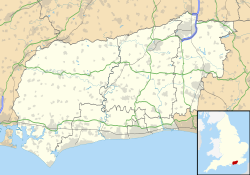| Lordington House | |
|---|---|
 Lordington House in 2011 | |
| General information | |
| Location | Near Walderton, West Sussex, England |
| Coordinates | 50°52′58″N0°53′25″W / 50.88274°N 0.89020°W |
| Year(s) built | c. 1500 (foundations) 1623 (house) [1] |
| Renovated | 18th century (reroofed and window openings) 1845 (kitchen wing) 1895 (remodelled) |
Listed Building – Grade II* | |
| Official name | Lordington House |
| Designated | 5 June 1958 |
| Reference no. | 1034423 |
Lordington House is a manor house near Walderton in West Sussex, England. It is a Grade II* listed building.
